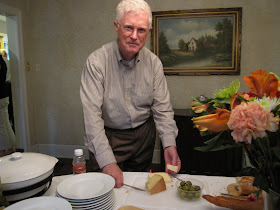
Morbier has always been one of my favorite party cheeses because it's sparky, but it doesn't overpower a room with the smell of feet. It's the color of a well-worn pearl earring, and it has the suppleness of a fine handbag. People who are afraid of strong cheese generally like it, and the mohawk of ash down the center makes people lean over, squint, and dig in. It's a cheese with curiosity. I think the Brontes would have served it. I think Mr. Rochester would have kept some in his larder, enjoying a few nostril-flaring bites when he came in from the heath, fresh off his horse.
There is something autumnal about Morbier -- think burning leaves, walnuts, orchard fruit. Steven Jenkins, in his wonderful Cheese Primer, calls it "the most seductive of all semisoft cheeses." He also compares the taste to veal sauteed in butter, which perhaps explains why it was such a hit with the Jesuits who attended the house-warming -- it's rumored that our Jesuits are fans of veal piccata.
Here you can see them, happily noshing.
I was delighted to have found a satisfying Jesuit-party cheese.
Morbier has a rich history. In the foothills of the Jura Mountains, French cheesemakers used the ash to separate the morning milk from the evening milk. The ash kept the flies away and prevented the cheese from drying out. I was fascinated to read about this process because the makers of Humboldt Fog, an exquisite California cheese, perform this very ritual. Most Morbier that's available in the States is not created from morning and evening milk, and the dark line is made of vegetable ash, not the ash from the copper pot where the curds were cooked -- the traditional method.
Still, Morbier is a pleaser. Read the label, and look for a Morbier that hales from Franche-Comte/Jura or Doubs origin. Then you have the real deal. Melted Morbier is terrific, especially over boiled potatoes, Raclette-style, but it's also fine at room temp, shmeared on bread, served with a light, fruity red and a bowl of walnuts. Try inviting some theologians or some crusty professors. An excellent pairing.




I love how I learn something every time I read your blog, Tenaya!
ReplyDeleteThat is great!! HAHAHA I'm sure Father Samway had something French to say about this occasion.
ReplyDeleteDelightful and dually noted! I should hope to be so astutely hospitable if I ever had the pleasure of cheesing with Fr. Feeney. Thanks for the pleasurable read.
ReplyDeleteYvette's in Stone Harbor, NJ uses Morbier in their grilled cheese sandwich. It's fabulous. Now I have to pop over to WF tomorrow morning so I can have some Morbier for lunch. Thanks for the reminder!
ReplyDeleteIt's really a shame that none of the guys came in priest drag (AKA the roman collar) for the cheese photographs. I hope you can bring some cheese to Kate Bornstein and get her on the blog, too.
ReplyDelete